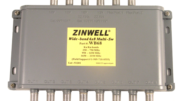So, if you’ve just bought yourself brand new smart TV and found out that you’re unable to stream your favorite shows then don’t worry, there’s one simple solution: use a VPN.
Luckily, there are a few ways to set up a VPN with a smart TV and they only require a little technological knowledge so you can be up and running within minutes.
A VPN works by tunneling your internet traffic to a remote server in a country of your choice, and then assigns a new IP address. With this new IP address you can unblock Geo-restricted content such as Netflix, YouTube, and other streaming services.
To enjoy uninterrupted streaming, you’ll first need to choose a VPN provider that’s not only fast but one that offers a vast amount of servers in the country that you need to connect through. For example, if you’re trying to unblock Netflix then you’re going to need a U.S. IP address to access their catalog, and you may need to try a few servers to find the best one. So, check how many servers a VPN offers, such as those found on this page.
1) Install a VPN on your Smart TV
If you’re using a newer smart TV, or have an Android TV box, then you’re off to a great start as you’ll be able to access the Google Play Store directly.
1) First ensure that you’ve purchased a VPN subscription from a top provider.
2) Search and download the VPN app from the Google Play Store.
3) Now, log into the VPN client and select the appropriate server for the content your wish to unblock.
4) Lastly, open up the app and you should now have unlocked this service.
It’s really that easy. However, if your smart TV isn’t Android compatible then there are more workarounds to explore.
2) Use your PC or Laptop as a WiFi Hotspot
You can turn your PC or laptop into a WiFi hotspot allowing other devices to connect to the internet via your computer. Better yet, you can also run a VPN at the same time meaning that all traffic gets tunneled through the VPN, so your smart TV doesn’t even require the installation of a VPN.
If you’re using Windows, follow these tips:
1) Make sure you’ve installed the latest VPN app from your provider.
2) Navigate to the ‘Network & Internet settings’.
3) Select ‘Mobile hotspot’, and also check the ‘Mobile hotspot’. Then in the ‘Share my Internet connection from’ dropdown menu select ‘WiFi’.
4) Now scroll down until your find ‘Change adapter options’, and then right-click the adapter which will be labelled with your VPN providers’ name.
5) Go to ‘Properties’, select the ‘Sharing’ tab. You need to enable to the option ‘Allow other network users to connect through this computer’s internet connection’.
6) Select your network that you’ve just created from the dropdown menu. Then click ‘OK’
7) Finally, connect to your VPN and then connect your Smart TV to the new network.
If you’re using Mac, here’s what to do:
1) Go to ‘System Preferences’, select the ‘Sharing’ tab.
2) Click on the ‘Internet Sharing’ box, and choose your VPN provider from the list under ‘Share your connection from’.
3) Choose ‘WiFi’ in the box named ‘To computers using’.
4) Finally, connect your Mac to the VPN, and then connect your smart TV to the new WiFi hotspot now created.
3) Connect your smart TV over Ethernet
When using Windows:
- Via the control panel, navigate to the ‘Network and Sharing Center’ and click on ‘Change adapter settings’.
- Find the name of your VPN connection. It may even be named ‘TAP-Win32’, for example. Right-click on this and choose ‘Properties’.
- Now choose the ‘sharing’ tab, and check the box that says ‘Allow other network users to connect through this computer’s internet’.
- Click on the drop-down menu and select ‘Local Area Connection’, and then click ‘OK’.
- Now you must restart your computer, and your SmartTV, to ensure everything will work smoothly.
When using a Mac:
- Connect your smart TV to your Mac via the Ethernet (or by using a USB to Ethernet adapter) and then navigate to the ‘System Preferences’ and click on ‘Sharing’.
- Click on the ’Internet sharing’ option on the left-hand side. Then using the pull-down the menu next to ‘Sharing your connection from’, select your VPN providers’ name that you want to connect your smart TV with.
- Check the box that says ‘USB Ethernet’ (next to ‘To computers using’).
- Then tick the box that says ‘internet sharing’ to switch this service on. A pop-up box will be displayed so click ‘Start’.
- Now restart your SmartTV.
4) Install a VPN on your home router
Installing a VPN on your router requires you to change the firmware by “flashing” the router. It’s perhaps the most technical way to connect your smart TV, and if not carried out properly, you may risk permanently damaging the router.
Also, not all routers are capable of this so first ensure your router is suitable. If not, or the above instructions just sound too cumbersome, then you can hit the ground running by purchasing a pre-flashed VPN router instead.
Overall, a VPN router is a great way to ensure that not just your smart TV is being tunneled through the VPN, but all other devices connected to router will benefit from the VPN too. It also means less messing around with cables and your smart TV no longer needs to sit near your computer for it to work.
5) Cast from a mobile or tablet
Another way to enjoy unblocked content via your smart TV is to broadcast from your smartphone or tablet which has the VPN installed, known as ‘screen mirroring’.
1) You’ll need to download a screen mirroring app, many of which can be found on Google Play or the Apple App Store.
2) Ensure that your TV and smart device are both connected to the same WiFi network.
3) Activate the ‘Miracast Display’ on your TV and enable the ‘Wireless Display’ option on your device.
4) Finally, select your Smart TV via the App and you’re good to go.
You must ensure your device is securely connected to a VPN server, and you’ll have to surf via the device not through your Smart TV. Effectively, your smart TV will only be acting as an external TV, so anything you view via the TV won’t be protected with the VPN.
Also, for this to work, you’ll need to keep your device near to your smart TV to ensure you have a strong enough signal reaching the TV.
Overall, there’s an option to suit everyone’s needs and technical abilities. To enjoy hassle-free streaming, make sure to choose a professional and trustworthy provider that offers an abundance of servers in many different countries.





